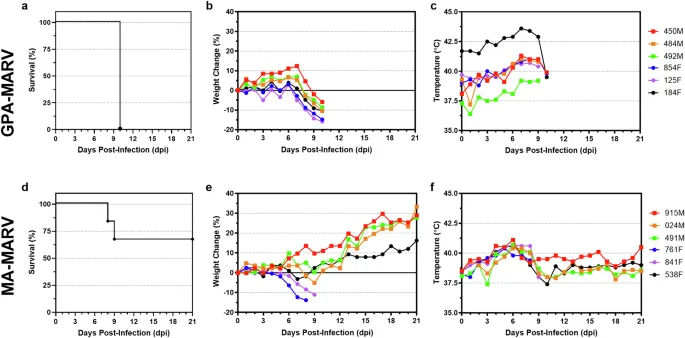
Deadly Marburg Virus Adapted for Ferrets: A Game-Changer in Filovirus Research!
2025-09-08
Author: Arjun
Unleashing the Dark Potential of Marburg Virus in Ferrets
In a groundbreaking study, researchers have unveiled the lethal capabilities of Marburg viruses adapted for domestic ferrets, presenting a terrifying twist in our understanding of filovirus pathogenesis. Unlike traditional rodent models, ferrets share striking anatomical and physiological similarities with humans, making them ideal subjects for studying severe infectious diseases.
The Ferret Model: A Significant Leap in Research
Traditionally, ferrets have shown resilience against Marburg virus (MARV) infections—a mystery, considering the virus wreaks havoc in humans and non-human primates. However, recent innovations in creating host-adapted viruses have turned the tide. By utilizing a guinea-pig adapted MARV (GPA-MARV), researchers established a model where these ferrets faced a uniformly lethal infection.
Clinical Signs and Virus Dynamics Explored
Ferrets infected with GPA-MARV succumbed to the disease within ten days, exhibiting symptoms reminiscent of human filovirus disease, including significant weight loss, elevated body temperature, and lethargy. In stark contrast, those infected with mouse-adapted MARV (MA-MARV) displayed only partial lethality, with one-third of the subjects surviving without serious clinical signs.
Viral Replication: GPA-MARV vs. MA-MARV
The viral dynamics were astonishing. GPA-MARV infections caused a sharp increase in viral RNA levels in ferrets, reaching alarming heights just five days post-infection. With GPA-MARV, viral presence was consistently observed in blood and tissues, while MA-MARV presented lower levels of viral RNA, correlating with milder symptoms.
The Immune Response: A Double-Edged Sword
A dysregulated immune response marked by elevated inflammatory cytokines was a hallmark for GPA-MARV-infected ferrets. These immune responses increased dramatically, reflecting those seen in severe human cases. However, MA-MARV-infected animals exhibited only slight increases in cytokine levels, aligning with their less severe clinical symptoms. This striking divergence highlights the complexity of the viral infection and immune interaction.
Mutation Insights: Unraveling the Virus's Secrets
Next-gen sequencing unveiled a series of mutations in the GPA-MARV strain, raising intriguing possibilities about how these changes enhance viral virulence. These mutations could play a crucial role in the virus's lethal behavior, particularly in evading host immune responses.
A Model for the Future: Implications for Public Health
This pioneering lethal ferret model for MARV not only offers insights into virulence but also sets the stage for evaluating potential treatments, especially in light of the urgent need for countermeasures amidst the ongoing MARV outbreak in Rwanda. This research marks a critical advancement in our ability to combat deadly viruses.
Conclusion: A Call to Action in Viral Research
As the world grapples with the threats posed by viral outbreaks, studies like these underscore the importance of innovative research models. The deadly nature of adapted MARV strains in ferrets opens new avenues for understanding and ultimately combating filovirus diseases in humans, reminding us of the unpredictable nature of viruses in an interconnected world.




 Brasil (PT)
Brasil (PT)
 Canada (EN)
Canada (EN)
 Chile (ES)
Chile (ES)
 Česko (CS)
Česko (CS)
 대한민국 (KO)
대한민국 (KO)
 España (ES)
España (ES)
 France (FR)
France (FR)
 Hong Kong (EN)
Hong Kong (EN)
 Italia (IT)
Italia (IT)
 日本 (JA)
日本 (JA)
 Magyarország (HU)
Magyarország (HU)
 Norge (NO)
Norge (NO)
 Polska (PL)
Polska (PL)
 Schweiz (DE)
Schweiz (DE)
 Singapore (EN)
Singapore (EN)
 Sverige (SV)
Sverige (SV)
 Suomi (FI)
Suomi (FI)
 Türkiye (TR)
Türkiye (TR)
 الإمارات العربية المتحدة (AR)
الإمارات العربية المتحدة (AR)